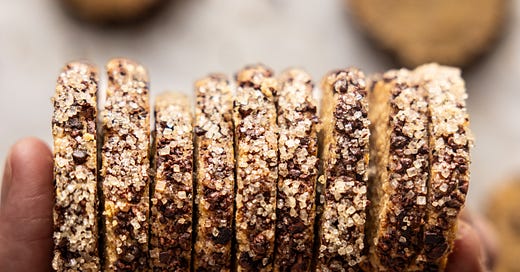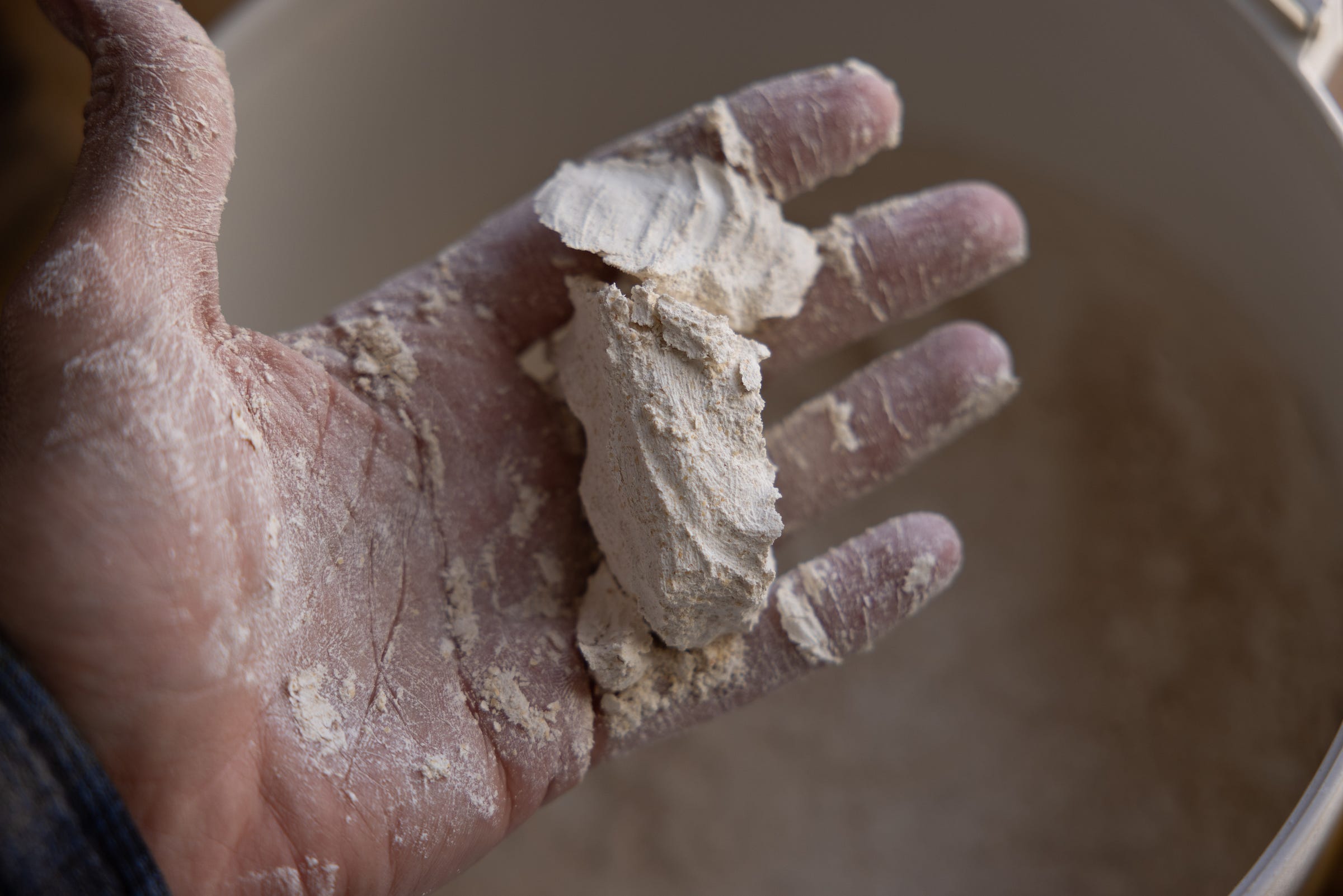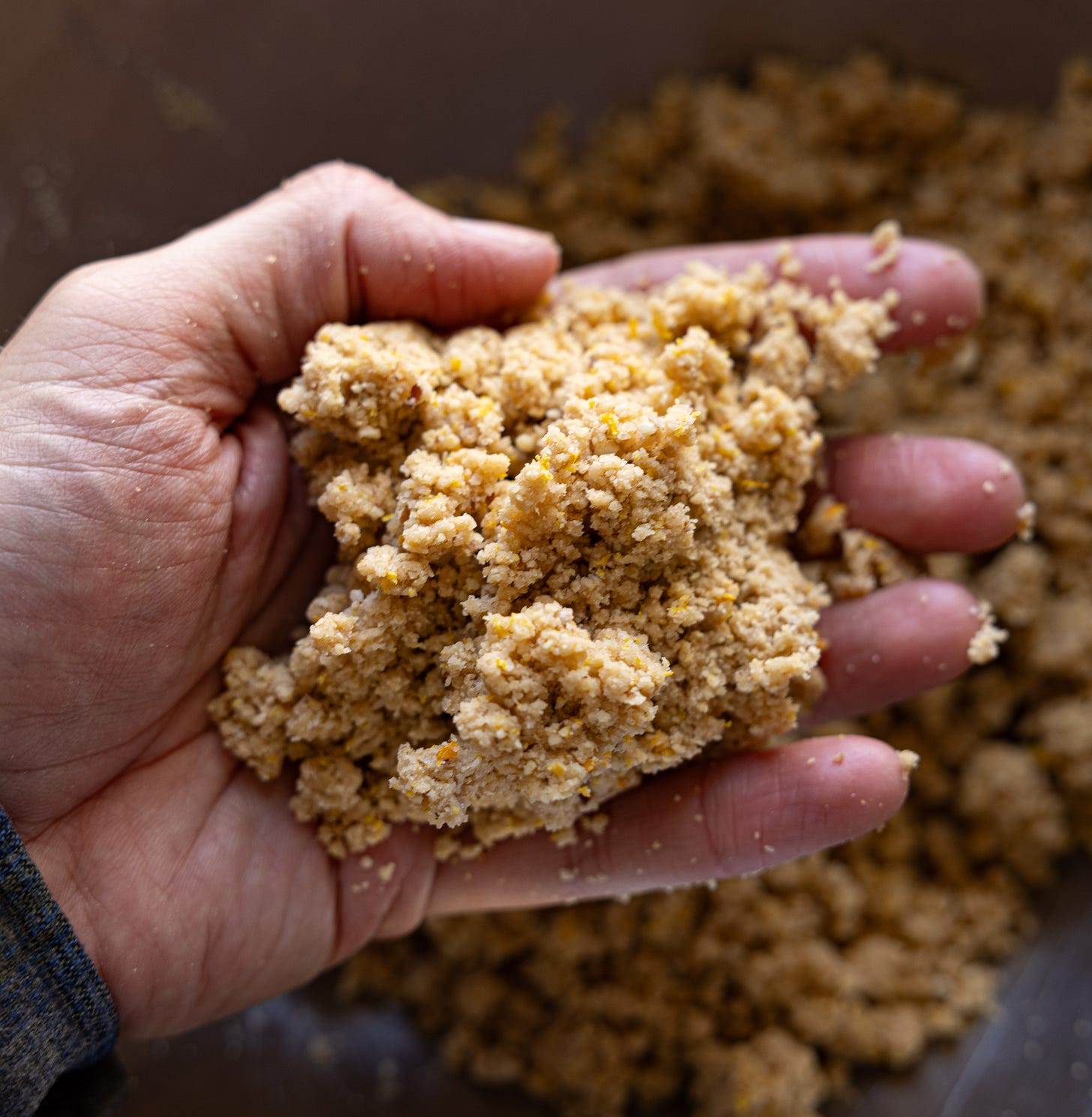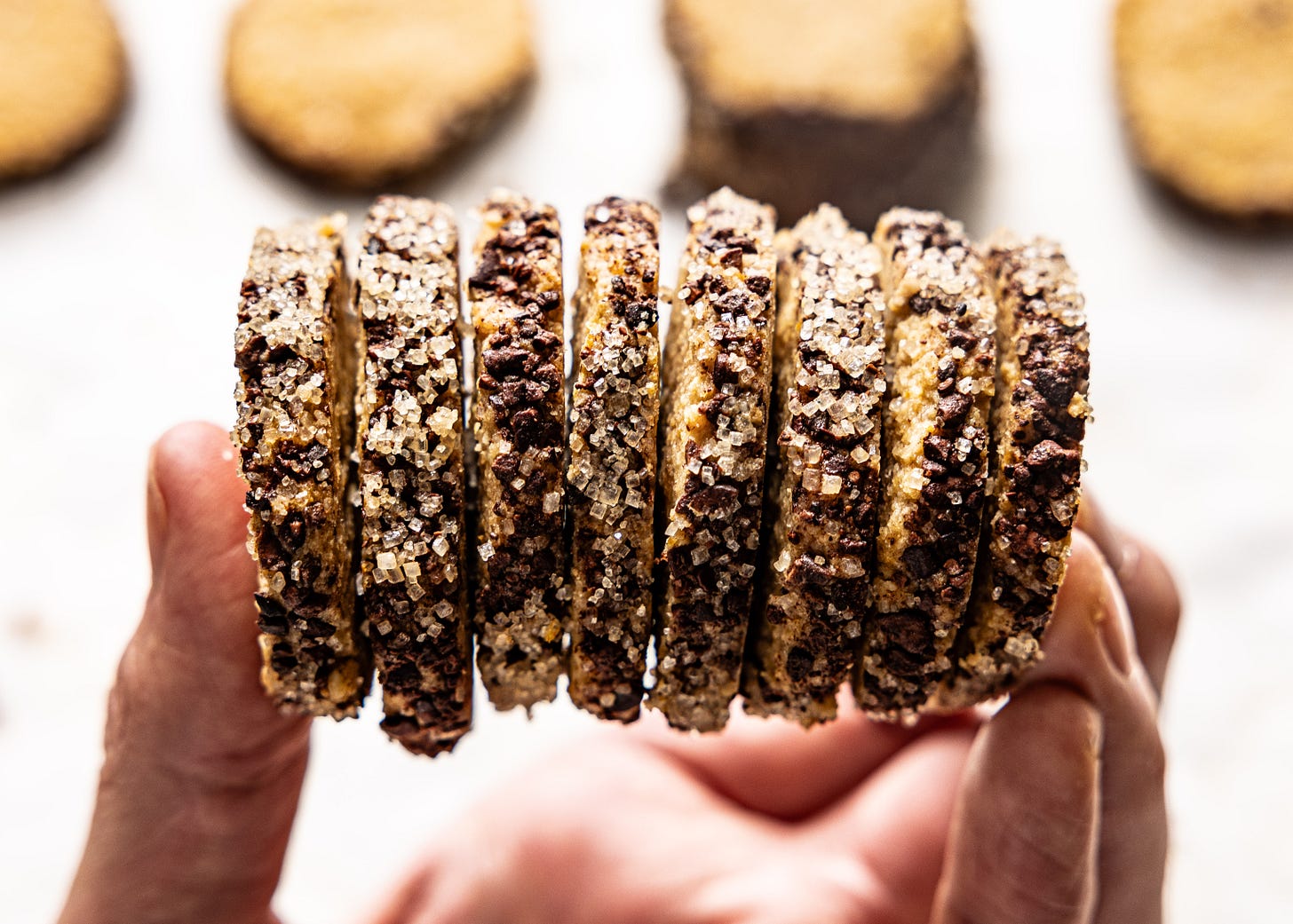A few days ago, while looking at my little flour mill and a jar of wheat berries on the shelf, I had a flashback: early 1980s, my elementary school lunchroom. Kids had their trays of hot food and lunchboxes, loaded with standard fare. I had mine, too, stowed on the floor between my feet. Inside that box, hidden as best as I could, was a misfit’s meal.
No Cheetos. No crustless sandwiches. No Hostess cupcakes, Pop Tarts, or even a basic bologna. For me, everything was homemade, wholegrain, and honey-sweetened. There would be no swapping.
But one day, hiding like Luke and Leia in a corner of that Empire Strikes Back lunchbox, by a brick of hard bread with homemade peanut butter, was something special. Buttery, nutty, salty, dotted with nuts — somehow they’d slipped past the granola guards … behold, a package of Pecan Sandies. I took the package out and waved it like a golden ticket before eating them in slow motion.
Flash to the present and I can buy a whole package of Sandies, make a sandwich and cut the crusts off, or eat Cheetos until I have an orange ring around my mouth. But guess what? The stuff that I hid has become the thing I hold high. So many years later, the tables have turned. Let’s make a whole wheat shortbread and add a few pecans.
Shortbread often follows the 3:2:1 rule. Three parts of flour, two of butter, and one of sugar, by weight. Starting with those ratios should get me close. But what else do I have? Soft wheat berries. Cacao nibs. Pecans. Navel oranges. A big block of local butter. Coarse sugar. And my little mill. Here we go.
I milled the soft wheat berries after biting one to see how tender it was. Definitely soft — that bodes well for a finely-milled flour. After milling I put the flour into the freezer to chill, then added pecans to my large mortar and pestle and ground them into a meal. I zested the orange, then grabbed the cold flour, stirred in the pecan meal, salt, brown sugar, and baking powder then massaged in the soft butter and zest. The dough came together easily.
Too easily, in fact. I had aimed high with the butter (too high), but I proceeded anyway, right past the warning signs, and chilled the dough after rolling it up into a tube. After an hour of cold, I ground the nibs in the mortar and pestle, mixed them with an equal weight of coarse sugar, and rolled the tube of dough through the mixture to coat all sides, then sliced, and baked.
While that first test spread too much to be considered shortbread, the flavors were beautiful. Subtle orange, nutty pecan notes, crunch and depth from the nibs and coarse sugar.
That evening I made them again. I adjusted the ratios slightly (good) but cut them too thickly (bad). So the next morning, another test, same ratios, a couple method changes, and a thinner slice before baking. They’re not exactly Sandies, but here I am. Old, new, the same, different, growing, changing, making my mistakes, and trying again. Is it not Spring?
Martin
A couple quick notes on the wheat berries, pecan meal, and nibs.
I’m milling soft wheat berries to the finest consistency possible in my home mill. If you don’t have a home mill, here are some choices: whole wheat pastry flour, whole spelt flour, or whole wheat flour blended with a little pastry or AP to lighten (75% WW, 25% white). King Arthur has a great new flour called, “Climate Blend” which is regeneratively grown, quite soft (meaning tender, a medium protein), and especially flavorful.
To make the pecan meal, grind whole pecans in a large mortar and pestle until they are quite fine, stopping just before they turn into nut butter. If you have a food processor and want to try that route, use the pulse function to get them as fine as you can, stopping before they become pecan butter. Note that chilled nuts will chop a little easier and resist the tendency to become a paste better than room temperature nuts.
To prepare the nibs, I grind them in a large mortar and pestle. You could probably also pulse in a food processor or small device (like a Ninja bullet, or similar). After grinding the mixture will range from some parts which are cocoa powder to pieces the size of millet or quinoa. If the pieces aren’t ground down to that size, the cookies come out looking a little clunky.
No nibs? In some areas, cacao nibs might be a special order. Where we are I had to check a couple stores before finding them in the bulk section. That being said, there are national chains that do carry them — even some Target stores. But, if your attempts to source don’t work and you don’t want to order, here’s my workaround: Using a chef’s knife, finely chop 40g of dark chocolate down to a fine consistency (about the size of a lentil), and add to the mix with the pecan meal and orange zest. Do still apply the coarse sugar crust.
Orange-Cacao Shortbreads
Freshly-milled soft wheat flour, 200g
Salt, fine, 5g (3/4 t)
Baking powder, 4g (1 t)
Pecan meal, 30g
Orange zest, 10g (one large navel)
Brown sugar, 65g
Butter, unsalted, 125g (room temperature)
The crust:
Cacao nibs, 40g
Turbinado or demerara sugar, 40g
Mix:
Into a medium bowl measure the flour, salt, and baking powder. If you’ve just milled the flour and it’s warm, place in the freezer to chill. Otherwise, gather the remaining ingredients.
Grind the pecans into a fine meal, and zest the orange.
Stir the dry ingredients to combine, then add the pecan meal, orange zest, and brown sugar, working the dough to a homogeneous consistency with your fingers.
Rub the butter into the dry mixture with your fingers, working to distribute it evenly. This will take a few minutes. As the butter combines a dough will begin to form. Continue to incorporate until the dough is a homogenous mass. *One note, if you find the dough is still hesitant to come together or, if it is overly crumbly, add a little milk, one large spoonful at a time. Depending on your flour, the fineness of milling, and ambient storage conditions, the moisture requirements may vary. Add just enough to bring the dough together.
Dump the dough onto your work surface and press into a log shape, then gently roll back and forth like a baguette into a log roughly 9” in length. Make the dough piece as even, smooth, and compact as possible.
Cacao nib crust:
Dump the ground nibs onto a clean sheet tray and flatten them into a single layer, about 9” wide and a couple inches in height. With a light mister or wet pastry brush, moisten the exterior of the dough then roll it through the nibs, pressing gently to help them adhere. Try to apply the crust as seamlessly and evenly as possible. The dough piece should pick up roughly all of the nibs.
Once the log is covered, place it on a piece of parchment and use a ruler or straight edge to make the cylinder as round, tight, and even as possible.
Chill for one to two hours. Towards the end of the chill, preheat the oven to 375°F.
After the chill, add coarse sugar to the sheet tray, spreading it to the same dimensions as the nibs. If necessary, use the mister or wet pastry brush to help as much of the sugar to adhere as possible.
Using a sharp knife with a thin blade, cut the dough into rounds, ¼” in width. When cut, move with a single swift downward motion, avoiding a sawing motion. As you cut, some of the nibs or sugar might fall off. After cutting pieces but before I transfer them to the sheet tray, I fix any pieces that have been deformed during cutting (making sure that they are round) and press them onto any extra nibs or sugar (using the bottom to pick up any extra bits) before placing them onto the trays.
Place the cookies onto a parchment-lined baking tray and garnish with a sprinkle of coarse salt, if desired.
Bake for 12 to 15 minutes, rotating as necessary. Being 100% whole wheat, judging doneness can be a little challenging — different than white flour, it’s hard to see the transition from raw to golden. But, the 12 to 15 minute range will get you close and, if you’re unsure, give them a few extra minutes and then leave them in the off oven for an additional 10 minutes to fully dry and crisp. They are better a little over and snappy rather than under and bendable.
One note here. These cookies take at least one hour to cool and develop the “short” consistency that we want. You can take one early (I always do) but know that they won’t be shortbread until fully, fully cooled and settled. If you find that they aren’t as “short” and crunchy as you like adjust your bake time for subsequent batches or, leave them in the off oven to cool as I note, above.








Fresh grain and orange must be intoxicating. I only have hard wheat kernels for my mill, but I do have pastry flour at hand. Decisions, decisions...
We had the good fortune to be deputized as "tasters" through at least 3 iterations. I loved them all, but the final one had that unique and wonderful shortbread texture, taste was lovely, and the coating on the outside was perfect.